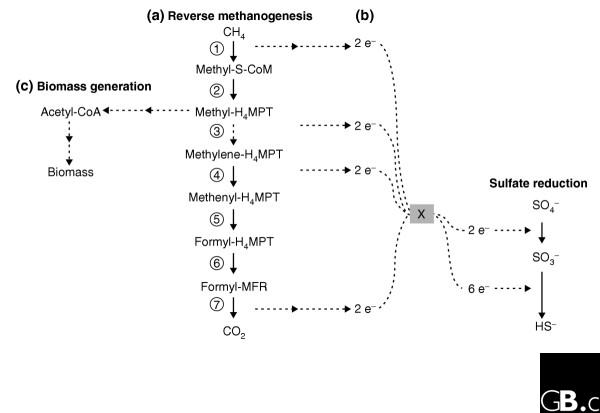Figure 1.

A proposed pathway for anaerobic oxidation of methane involving the homolog of methyl-CoM reductase and a novel methylene-tetrahydromethanopterin (H4MPT) reductase (Mer), and its connection with the sulfate reduction pathway. (a) The reverse methanogenesis pathway. Solid arrows represent enzymes predicted from the sequences found by Hallam et al. [3]; the dotted arrow represents the one enzyme that was not predicted, methylene H4MPT-reductase (Mer). Enzymes performing steps 1-7: 1, Methyl-CoM reductase-like protein (MCR); 2, Methyl-H4MPT:coenzyme M (CoM) methyl-transferase (Mtr); 3, Methylene-H4MPT reductase (Mer); 4, F420-dependent methylene-H4MPT dehydrogenase (Mtd); 5, Methenyl-H4MPT cyclohydrolase (Mch); 6, Formyl-MFR:H4MPT formyltransferase (Ftr); 7, Formyl-MFR dehydrogenase (Fmd). (b) Reverse methanogenesis is thought to be connected to sulfate reduction through an unknown intermediate (X); e- represents an electron. Hallam et al. [3] suggest that steps 1 and 2 in (a) function in the down direction and methyl-H4MPT is used for biomass generation (c), while steps 4 to 7 function in the up direction and the methylene-H4MPT produced is either converted to biomass through the serine cycle or is oxidized to CO2. We suggest that Mer or an analogous enzyme probably performs step 3 instead.
